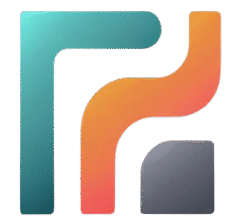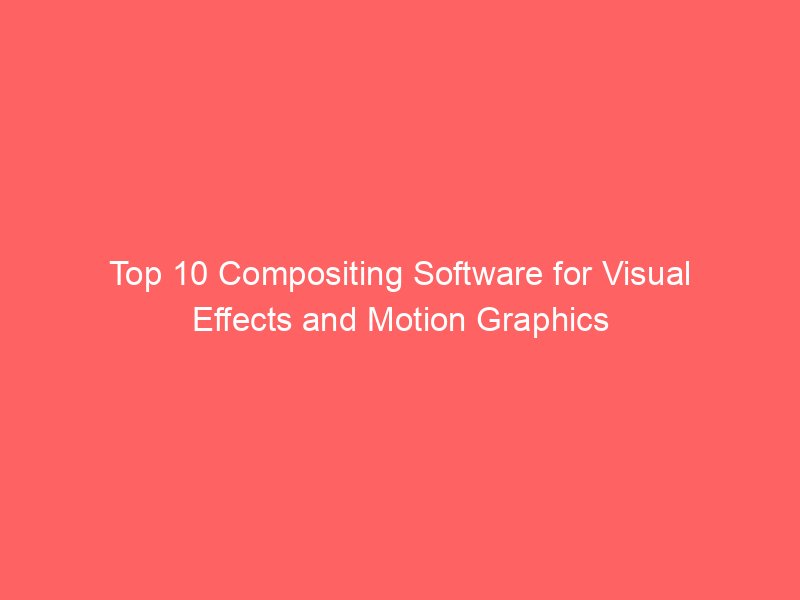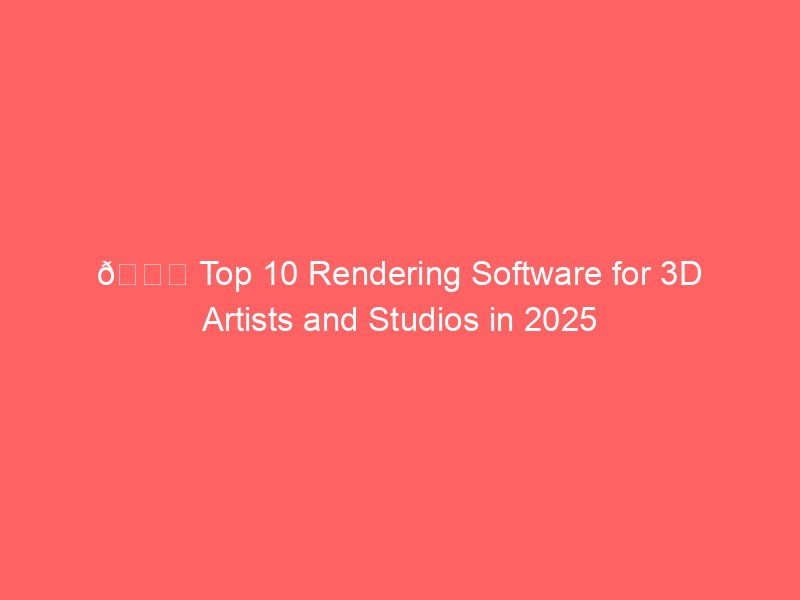In the world of film, television, gaming, and advertising, compositing software plays a crucial role. It allows creators to seamlessly blend visual elements like CGI, green-screen footage, live-action, matte paintings, and particle effects into a single, polished scene. Without compositing software, blockbusters like Avengers, Avatar, or Inception would not look as visually stunning as they do today.
Below is a detailed look at the Top 10 Compositing Software used by professionals and enthusiasts alike, along with their key features, pros, cons, and ideal use cases.
1. Adobe After Effects
Best for motion graphics and 2.5D compositing
Adobe After Effects is arguably the most popular compositing and motion graphics software on the market. It is widely used in TV, film, and advertising for creating everything from VFX shots to animated titles.
Key Features:
- Powerful keying tools for green-screen removal
- Integration with Adobe Creative Cloud (Premiere Pro, Photoshop, Illustrator)
- Huge library of plugins and templates
- Expressions and scripting for automation
- GPU-accelerated rendering with Adobe’s Dynamic Link
Pros:
- Beginner-friendly with tons of tutorials
- Huge plugin ecosystem
- Strong motion graphics features
Cons:
- Limited 3D capabilities compared to dedicated VFX tools
- Can be slow with very heavy projects
Best For: Motion designers, video editors, YouTubers, and filmmakers needing polished compositing and animation.
2. Nuke (by Foundry)
Best for high-end film compositing
Nuke is the industry standard for Hollywood VFX. From Game of Thrones to Star Wars, many iconic productions have used Nuke’s advanced compositing workflow.
Key Features:
- Node-based compositing (better for large, complex projects)
- Powerful 3D compositing environment
- Deep image compositing for managing 3D render passes
- Advanced color management (ACES workflow)
- Strong tracking, keying, and rotoscoping tools
Pros:
- Industry-standard for high-end VFX
- Extremely flexible node-based workflow
- Handles large, complex projects with ease
Cons:
- Expensive license (thousands of dollars annually)
- Steep learning curve
Best For: VFX studios, film professionals, and advanced compositors working on blockbuster movies.
3. Blackmagic Fusion
Best free alternative to Nuke
Fusion, now integrated into DaVinci Resolve, is a node-based compositing software with strong VFX and motion graphics features. It has been used in films like Avatar and The Hunger Games.
Key Features:
- Node-based workflow similar to Nuke
- Advanced rotoscoping, tracking, and keying tools
- VR and 3D compositing support
- Integrated with DaVinci Resolve for editing and color grading
Pros:
- Free version available
- Great for both editing + compositing workflows
- Powerful for a no-cost tool
Cons:
- Smaller community compared to After Effects
- Less plugin availability than Adobe ecosystem
Best For: Freelancers, indie filmmakers, and studios on a budget who still want professional-grade compositing.
4. Autodesk Flame
Best for broadcast and high-end finishing
Flame is a high-end compositing, finishing, and color grading software used in commercials, broadcast, and high-budget film productions.
Key Features:
- Timeline-based editing + node-based compositing hybrid
- AI-driven features like sky replacement
- Advanced 3D tracking and particle systems
- Real-time playback with GPU acceleration
Pros:
- Great for finishing workflows (edit, color, and VFX in one)
- Trusted in commercial post-production
- Robust real-time performance
Cons:
- Very expensive (over $5,000 per year)
- Requires high-end hardware
Best For: Broadcast studios, advertising agencies, and top-tier post-production houses.
5. HitFilm Pro
Best for YouTubers and indie filmmakers
HitFilm Pro combines video editing with powerful compositing tools, making it a great option for content creators who need everything in one package.
Key Features:
- Integrated video editing and VFX tools
- 3D compositing with particle effects
- Pre-built VFX templates for quick editing
- Support for green-screen removal and advanced keying
Pros:
- Affordable compared to After Effects or Nuke
- User-friendly for beginners
- Strong all-in-one package
Cons:
- Lacks the depth of high-end VFX tools
- Limited support for large studio workflows
Best For: YouTubers, small studios, and independent filmmakers.
6. Apple Motion
Best for Mac users and Final Cut Pro editors
Apple Motion is Apple’s answer to Adobe After Effects, providing compositing, motion graphics, and visual effects at an affordable price.
Key Features:
- Tight integration with Final Cut Pro
- Real-time performance on Mac hardware
- Particle systems and 2D/3D compositing tools
- Affordable one-time purchase model
Pros:
- Extremely cost-effective ($49.99 one-time purchase)
- Optimized for Mac performance
- Easy to learn for beginners
Cons:
- Mac-only
- Not as feature-rich as After Effects or Fusion
Best For: Mac-based editors and Final Cut Pro users who want affordable compositing.
7. Blender (Compositor)
Best free open-source option
Blender is known for 3D modeling and animation, but it also has a built-in node-based compositor. It’s a great free solution for integrating VFX into 3D workflows.
Key Features:
- Node-based compositing engine
- Full integration with Blender’s 3D tools
- Motion tracking, rotoscoping, and masking
- Support for advanced passes like Z-depth and vector blur
Pros:
- 100% free and open-source
- Strong for 3D + compositing workflows
- Active community
Cons:
- Compositing features not as advanced as Nuke
- UI can be overwhelming for beginners
Best For: Indie filmmakers, 3D artists, and hobbyists who want an all-in-one tool.
8. Natron
Best open-source Nuke alternative
Natron is a free, open-source, node-based compositor inspired by Nuke. It’s designed for professionals who want a no-cost option.
Key Features:
- Node-based workflow like Nuke and Fusion
- Keying, tracking, rotoscoping tools
- Plugin support via OpenFX
- Cross-platform (Windows, Mac, Linux)
Pros:
- Free and open-source
- Lightweight but powerful
- Great for learning node-based compositing
Cons:
- Limited development activity
- Lacks some advanced features of Nuke or Fusion
Best For: Beginners, students, and indie VFX artists.
9. Boris FX Silhouette
Best for rotoscoping and paint work
Silhouette is highly respected in the VFX industry, especially for roto and paint tasks. It’s often used alongside other compositing tools.
Key Features:
- Industry-leading rotoscoping tools
- Planar tracking and advanced keying
- Paint system for removing wires, rigs, and unwanted objects
- Stereo 3D support
Pros:
- Excellent roto and paint features
- Trusted by major studios
- Works as standalone or plugin
Cons:
- Expensive
- Not a full compositing suite (better as companion software)
Best For: Professional compositors handling rotoscoping and cleanup.
10. Mocha Pro (by Boris FX)
Best for planar tracking and rotoscoping
Mocha Pro is another specialized compositing software, mainly known for its planar tracking and advanced rotoscoping.
Key Features:
- Planar tracking (industry standard)
- Rotoscoping and object removal
- Lens correction and stabilization
- Plugin support for After Effects, Nuke, and more
Pros:
- Best-in-class tracking tools
- Works well alongside other VFX software
- Saves huge amounts of time on tracking
Cons:
- Expensive
- Not a full compositor
Best For: VFX professionals who need accurate tracking and roto for integration into larger pipelines.
Final Thoughts
Compositing software is the backbone of modern filmmaking, advertising, and content creation. If you’re a beginner, tools like After Effects, HitFilm Pro, or Apple Motion are great starting points. For professional film studios, Nuke, Fusion, or Flame offer the advanced capabilities required for blockbuster-level VFX. Meanwhile, Blender, Natron, and Mocha Pro provide budget-friendly or specialized solutions.
Choosing the right compositing software depends on your budget, project type, and pipeline needs. Whether you’re editing YouTube videos or working on a Hollywood production, there’s a compositing tool out there that fits your workflow.





